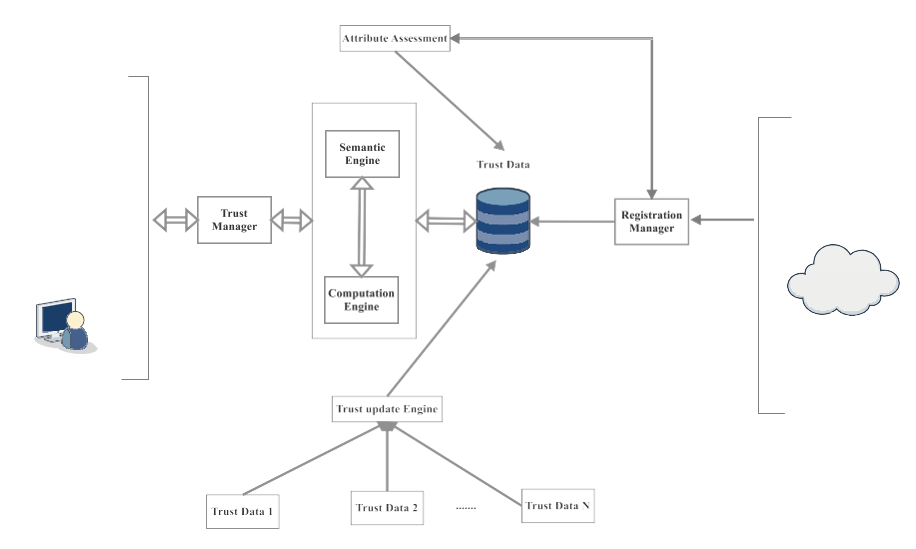Study of Trust Aggregation Authentication Protocol
Main Article Content
Abstract
The main focus of this work is to sense and share the data that are required to be trusted and the solutions are to be provided to the data, as trust management models. Additionally, the elements in the IoT network model are required to communicate with the trusted links, hence the identity services and authorization model are to be defined to develop the trust between the different entities or elements to exchange data in a reliable manner. Moreover, data and the services are to be accessed from the trusted elements, where the access control measures are also to be clearly defined. While considering the whole trust management model, identification, authentication, authorization and access control are to be clearly defined.
Article Details
References
Naresh P and Debasis D, 2017, “Algorithm for Trust Based Policy Hidden Communication in the Internet of Things,” IEEE Computer Society, Vol-4, pp. 148-153.
ZeeshanA K , Johanna U , Artemios G. Voyiatzis, and Peter H , 2017, “A Trust-based Resilient Routing Mechanism for the Internet of Things,” ACM International Conference on Availability, Reliability and Security, Vol.27 pp. 1- 6.
Upul J , GyuMyoung L , Tai-Won Um, Qi Shi, 2019, “Machine Learning based Trust Computational Model for IoT Services,” IEEE Transactions on Sustainable Computing, Vol-4, pp. 39-51.
António P and Ricardo C 2016, “Hash-Chain-Based Authentication for IoT,” Advances in Distributed Computing and Artificial Intelligence Journal, Vol.-5, No. 4, pp. 43-57.
Khirod C S and Umesh C P, 2017, “IoT Based Intrusion Detection System Using PIR Sensor,” 2nd IEEE International Conference On Recent Trends in Electronics Information-&-Communication-Technology), pp. 1641-1645.
Rohan D, NoahA and Nick F, 2018, “Machine Learning DDoS Detection for Consumer Internet of Things Devices,” ArXiv Journal Publications, pp. 29-35.
Hanif R, Jinshan L and Jung-M (Jerry) Park, 2018, “Secure Match: Scalable Authentication and Key Relegation for IoT Using Physical-Layer Techniques,” IEEE Conference on Communications and Network Security, pp. 1-9. 146
Zheng, Dehua; Hong, Zhen; Wang, Ning; Chen, Ping. 2020, “An Improved LDA-Based ELM Classification for Intrusion Detection Algorithm in IoT Application,” Sensors Vol.20, No. 6.
Otoum, Yazan& Liu, Dandan&Nayak, Amiya. 2019, “DL?IDS: A Deep Learning–Based Intrusion Detection Framework For Securing IoT,” Transactions on Emerging Telecommunications Technologies, Vol.30 No.11.
Yulong Fu, Zheng Yan, Jin Cao, OusmaneKoné, Xuefei Cao 2017, “An Automata Based Intrusion Detection Method for Internet of Things,” Mobile Information Systems, Vol,2017, pp.1-13.
Hamza, Ayyoob&HabibiGharakheili, Hassan &Sivaraman, Vijay. 2018, “Combining MUD Policies with SDN for IoT Intrusion Detection,” Proceedings on IoT Security& Privacy”. pp 1-7.
M. Azarmehr, A. Ahmadi and R. Rashidzadeh, 2017, “Secure Authentication and Access Mechanism for IoT Wireless Sensors,” IEEE International Symposium on Circuits and Systems (ISCAS), Baltimore, MD, USA, 2017, pp. 1-4.
C. Guo, R. Zhuang, Y. Jie, Y. Ren, Ting Wu and K.K. R.Choo, 2016, “Fine- Grained Database Field Search using Attribute-Based Encryption for E-healthcare Clouds,” Journal of Medical Systems, Vol. 40, No. 11, pp. 1-8.
Y. Yang, 2015, “Attribute-Based Data Retrieval with Semantic Keyword Search for e-Health Cloud,” Journal of Cloud Computing, Vol. 4, No. 1, pp. 1-6.
N. Shekokar, K. Sampat, C. Chandawalla and J. Shah, 2015, “Implementation of Fuzzy Keyword Search over Encrypted Data in Cloud Computing,” Procedia Computer Science, Vol. 45, pp. 499-505.
Z. Fu, J. Shu, X. Su and D. Zhang, 2014, “Semantic Keyword Search Based on Tier over Encrypted Cloud Data,” Proceedings of the 2ndInternational Workshop on Security in Cloud Computing, ACM, pp. 59-62.

